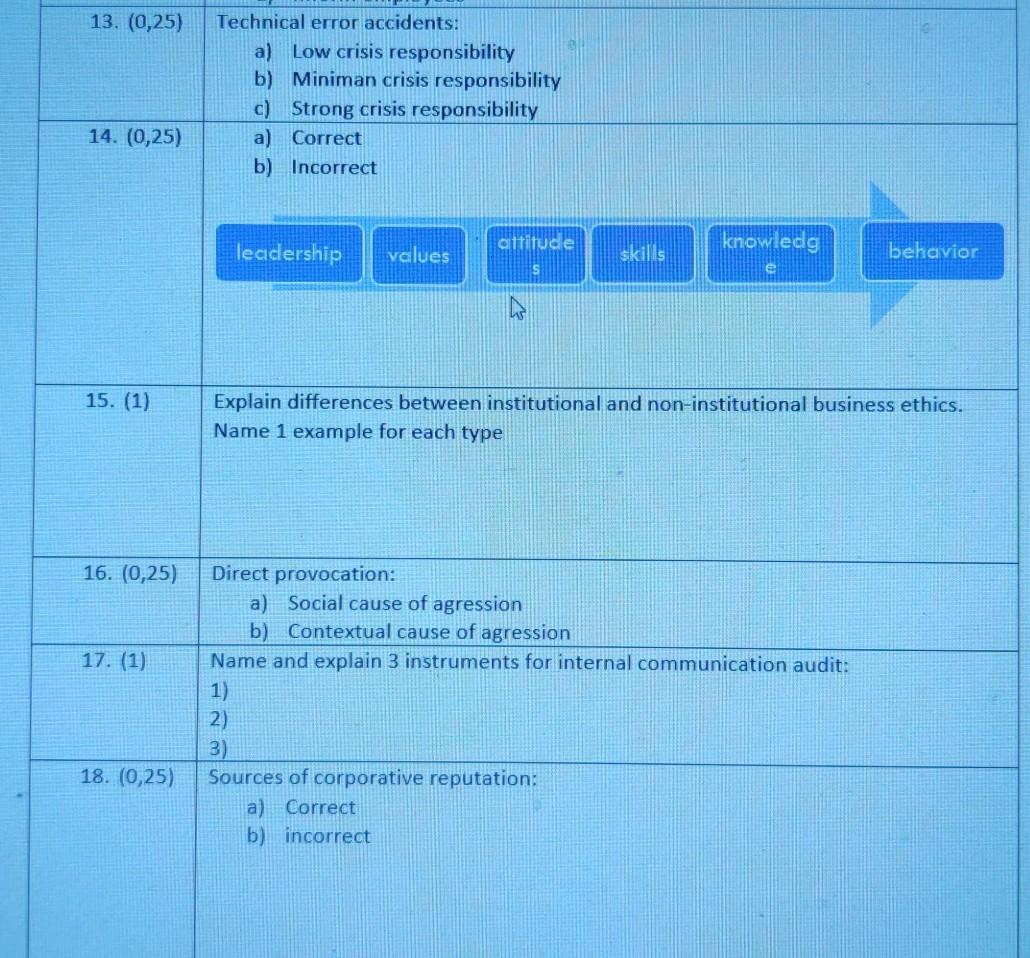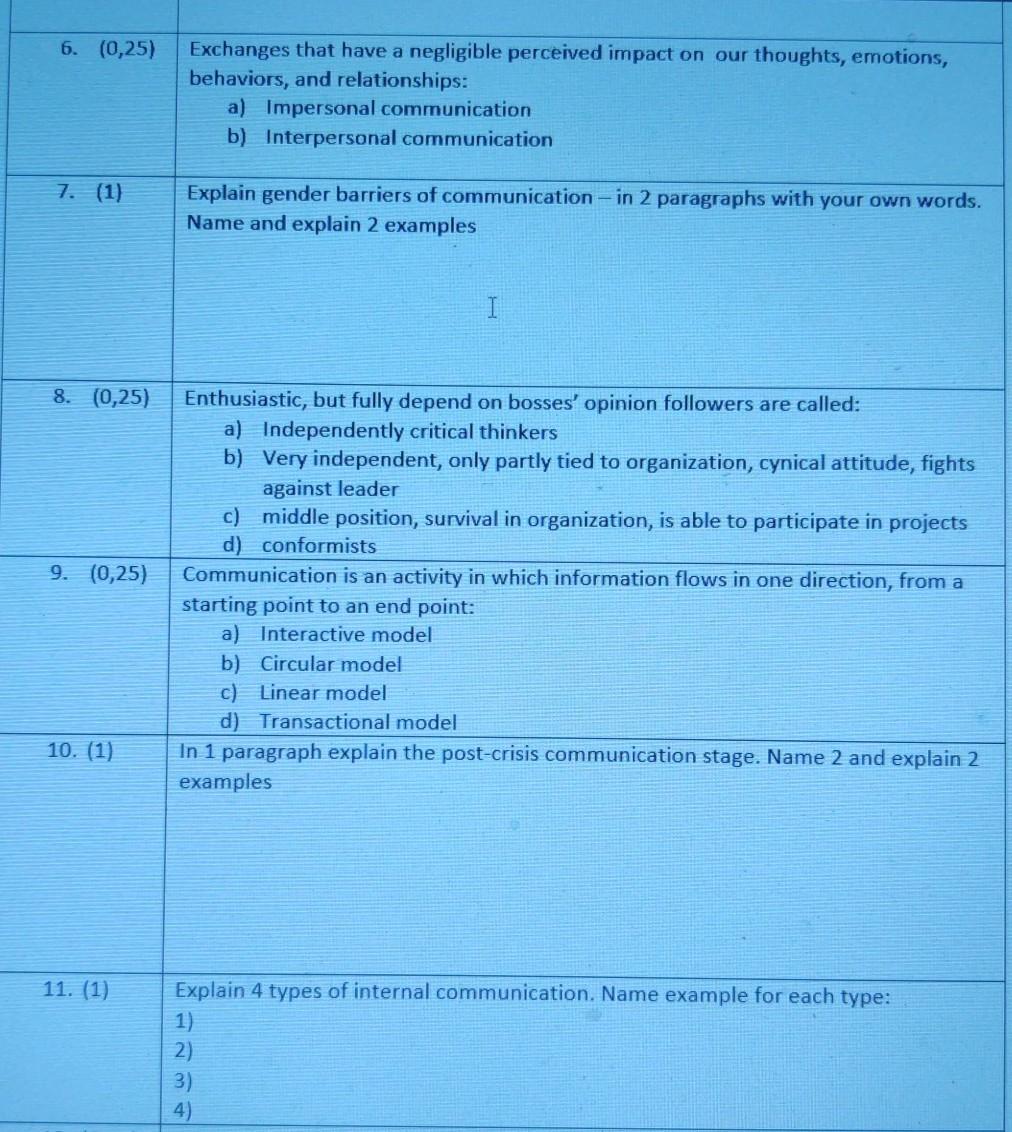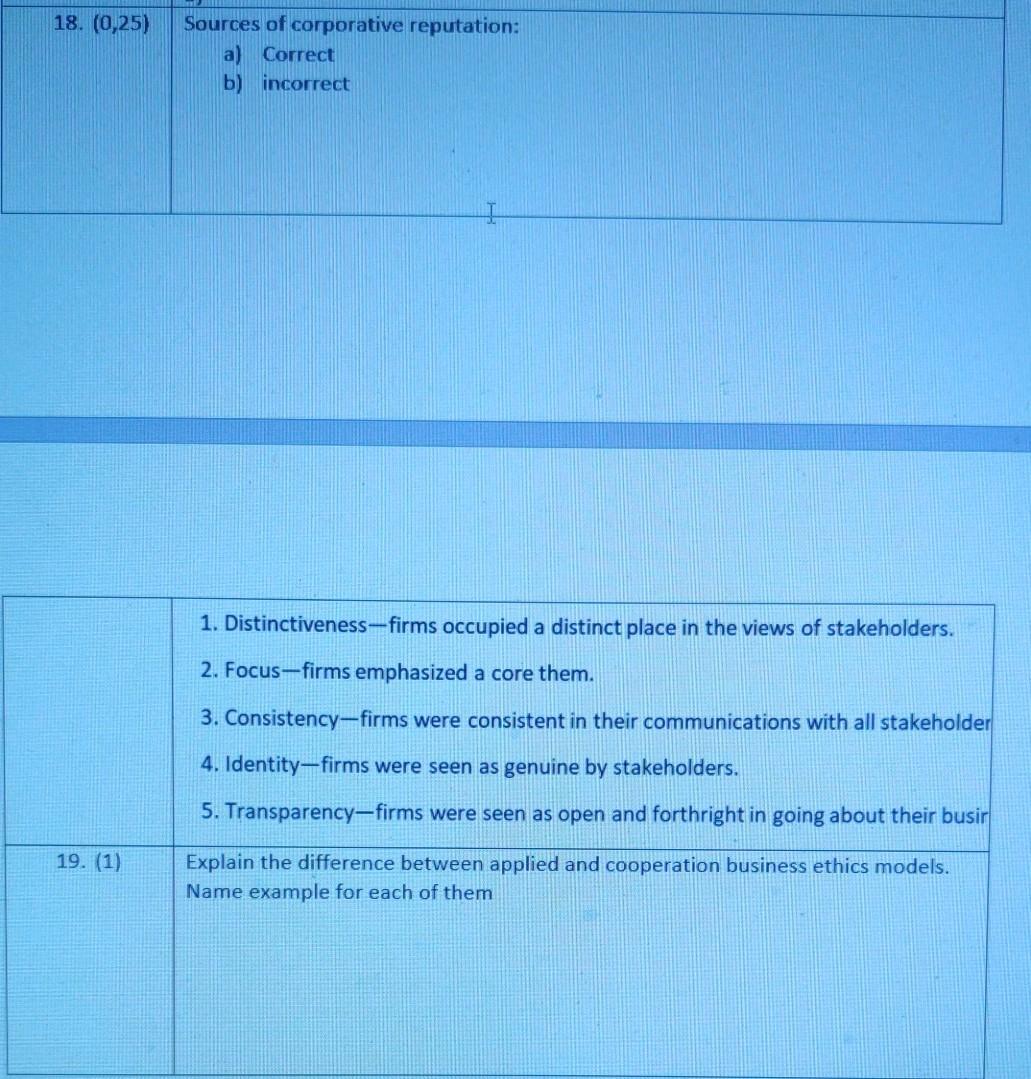Answered step by step
Verified Expert Solution
Question
1 Approved Answer
it's based on the subject business ethics No. 1. (0,25) Question Win/win strategy Free info exchange Interests of all parties are taken into account Win/lose


it's based on the subject business ethics


No. 1. (0,25) Question Win/win strategy Free info exchange Interests of all parties are taken into account Win/lose strategy Hidden information Dominating interests Paritary discussion Common goals Problem resolution Discussion from power position Different goals Fascing opinion Quarrel Creating relations Explanation Sacrificing relations in the name of task 2. (0,25) 3. (0,25) Problem People a) Correct b) Incorrect Reputation is related with the customers' and stakeholders' association related to the company: a) Communication approach b) Strategical approach c) Marketing approach d) Organizational theory approach Leaders as models of behavior: a) Serving leadership b) Transformative leadership c) Authentic leadership d) Model leadership Ethics. Rules are not broken but the inethical actions are permisible if they ar within the limits of legislation: a) Rule based approach b) Instrumental approach c) Ethical relativism d) Approach based on principles How does good reputation enhance relationship with NGOs? Explain in 1 chapter and name 2 examples: 4. (0,25) 5. (1) 13. (0,25) Technical error accidents: a) Low crisis responsibility b) Miniman crisis responsibility c) Strong crisis responsibility a) Correct b) Incorrect 14. (0,25) attitude leadership knowledg values skills behavior S 15. (1) Explain differences between institutional and non-institutional business ethics. Name 1 example for each type 16. (0,25) 17. (1) Direct provocation: a) Social cause of agression b) Contextual cause of agression Name and explain 3 instruments for internal communication audit: 1) 2) 3) Sources of corporative reputation: a) Correct b) incorrect 18. (0,25) 6. (0,25) Exchanges that have a negligible perceived impact on our thoughts, emotions, behaviors, and relationships: a) Impersonal communication b) Interpersonal communication 7. (1) Explain gender barriers of communication - in 2 paragraphs with your own words. Name and explain 2 examples I 8. (0,25) 9. (0,25) Enthusiastic, but fully depend on bosses' opinion followers are called: a) Independently critical thinkers b) Very independent, only partly tied to organization, cynical attitude, fights against leader c) middle position, survival in organization, is able to participate in projects d) conformists Communication is an activity in which information flows in one direction, from a starting point to an end point: a) Interactive model b) Circular model c) Linear model d) Transactional model In 1 paragraph explain the post-crisis communication stage. Name 2 and explain 2 examples 10. (1) 11. (1) Explain 4 types of internal communication. Name example for each type: 1) 2) 3) 4) 18. (0,25) Sources of corporative reputation: a) Correct b) incorrect 1. Distinctiveness-firms occupied a distinct place in the views of stakeholders. 2. Focus-firms emphasized a core them. 3. Consistency-firms were consistent in their communications with all stakeholder 4. Identity-firms were seen as genuine by stakeholders. 5. Transparency-firms were seen as open and forthright in going about their busir 19. (1) Explain the difference between applied and cooperation business ethics models. Name example for each of them No. 1. (0,25) Question Win/win strategy Free info exchange Interests of all parties are taken into account Win/lose strategy Hidden information Dominating interests Paritary discussion Common goals Problem resolution Discussion from power position Different goals Fascing opinion Quarrel Creating relations Explanation Sacrificing relations in the name of task 2. (0,25) 3. (0,25) Problem People a) Correct b) Incorrect Reputation is related with the customers' and stakeholders' association related to the company: a) Communication approach b) Strategical approach c) Marketing approach d) Organizational theory approach Leaders as models of behavior: a) Serving leadership b) Transformative leadership c) Authentic leadership d) Model leadership Ethics. Rules are not broken but the inethical actions are permisible if they ar within the limits of legislation: a) Rule based approach b) Instrumental approach c) Ethical relativism d) Approach based on principles How does good reputation enhance relationship with NGOs? Explain in 1 chapter and name 2 examples: 4. (0,25) 5. (1) 13. (0,25) Technical error accidents: a) Low crisis responsibility b) Miniman crisis responsibility c) Strong crisis responsibility a) Correct b) Incorrect 14. (0,25) attitude leadership knowledg values skills behavior S 15. (1) Explain differences between institutional and non-institutional business ethics. Name 1 example for each type 16. (0,25) 17. (1) Direct provocation: a) Social cause of agression b) Contextual cause of agression Name and explain 3 instruments for internal communication audit: 1) 2) 3) Sources of corporative reputation: a) Correct b) incorrect 18. (0,25) 6. (0,25) Exchanges that have a negligible perceived impact on our thoughts, emotions, behaviors, and relationships: a) Impersonal communication b) Interpersonal communication 7. (1) Explain gender barriers of communication - in 2 paragraphs with your own words. Name and explain 2 examples I 8. (0,25) 9. (0,25) Enthusiastic, but fully depend on bosses' opinion followers are called: a) Independently critical thinkers b) Very independent, only partly tied to organization, cynical attitude, fights against leader c) middle position, survival in organization, is able to participate in projects d) conformists Communication is an activity in which information flows in one direction, from a starting point to an end point: a) Interactive model b) Circular model c) Linear model d) Transactional model In 1 paragraph explain the post-crisis communication stage. Name 2 and explain 2 examples 10. (1) 11. (1) Explain 4 types of internal communication. Name example for each type: 1) 2) 3) 4) 18. (0,25) Sources of corporative reputation: a) Correct b) incorrect 1. Distinctiveness-firms occupied a distinct place in the views of stakeholders. 2. Focus-firms emphasized a core them. 3. Consistency-firms were consistent in their communications with all stakeholder 4. Identity-firms were seen as genuine by stakeholders. 5. Transparency-firms were seen as open and forthright in going about their busir 19. (1) Explain the difference between applied and cooperation business ethics models. Name example for each of them
Step by Step Solution
There are 3 Steps involved in it
Step: 1

Get Instant Access to Expert-Tailored Solutions
See step-by-step solutions with expert insights and AI powered tools for academic success
Step: 2

Step: 3

Ace Your Homework with AI
Get the answers you need in no time with our AI-driven, step-by-step assistance
Get Started


